When you’re in the Volunteer State, you could see up to 20 different species of turtles. There are endangered turtles such as the tiny Bog turtle, big ones like Alligator Snapping turtles, and flattened but wide Softshell turtles.
Tennessee is crisscrossed by rivers, streams, and other waterways as well as forests, grasslands, and mountains. All of these areas are perfect for turtles.
Whether you are a wildlife enthusiast and just want to see these turtles in the wild or you are looking for a native pet turtle, this list will give you plenty of information.
If you are looking for a pet, check out this adoptions page first. Maybe you could rescue a turtle in need.
With all that said, let’s examine the 20 species of turtles native to Tennessee.
Table of Contents
Turtles in Tennessee
1) Bog Turtle
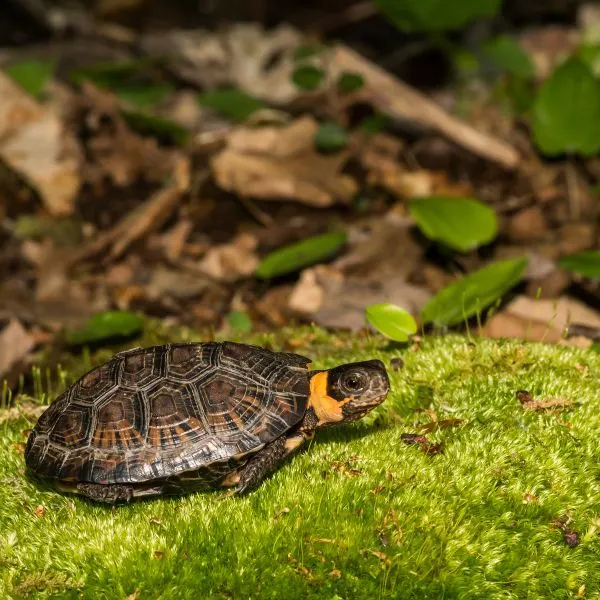
- Experience Level: *Expert
- Family: Emydidae
- Scientific Name: Glyptemys muhlenbergii
- Other Names: Muhlenberg’s turtle
- Adult Size: 3.5 to 5 inches (9 to 12.5 cm)
- Life Span: Up to 60 years in the wild
- Average Price Range: *Illegal to own, Federally protected species
- Conservation Status: Endangered
America’s smallest and most endangered turtle, the Bog Turtle is a flagship species. This means the turtle is so small and cute that people want to save it, and in order to keep it from going extinct, its habitat needs to be saved.
Bog turtles live in (shrugs) bogs, as well as swamps and other wetland habitats. America’s wetlands are being drained, filled in, and getting developed, so saving the Bog turtle will also help to preserve these habitats which many other animals and plants rely on.
To identify these tiny turtles, look for a dark brown to black shell with a slight ridge down the middle. You may see a very faint starburst pattern on the carapace—or the upper shell. The most identifying marks are large reddish-orange marks just behind the eyes that may connect to make a ring.
These turtles spend time both on land and in the water. They will eat insects, worms, mollusks, and plant material.
Box Turtles in Tennessee
2) Eastern Box Turtle

- Experience Level: Beginner
- Family: Emydidae
- Scientific Name: Terrapene carolina carolina
- Other Names: Land Turtle
- Adult Size: 4 to 7 inches
- Life Span: 50 to 100 years
- Average Price Range: $260 – $360
- Conservation Status: Michigan, New Hampshire, Massachusetts, Tennessee, and Connecticut—list the animal as a species of special concern, and Maine lists the turtle as endangered.
The State Reptile of Tennessee, Eastern Box Turtles are found in most areas of the state. They may be around your property but you may never see them, because they don’t roam far, and they spend a lot of time hiding in leaf litter, under rotted logs, and in the soil when it is too hot or cold.
These turtles prefer humid forests, thick grasslands, and wooded areas with a water source not too far away. They don’t swim often, and when they do, they’re clumsy, but they like to soak in the shallows when it’s dry and hot.
Eastern Box turtles have a very domed shell that’s dark brown or olive, with yellow or orange markings. Some may look like paint was dripped on them. Their scales are the same colors as the shell.
The plastron—a fancy name for the bottom part of the shell—is dual hinged. It can close tightly to protect it from predators.
Throughout their lifetime, Eastern Box turtles won’t roam more than a couple of hundred yards from where they were born. While they are out and about, they search for food such as mushrooms, berries, seeds, worms, insects, beetles, and carrion.
3) Three-toed Box Turtle
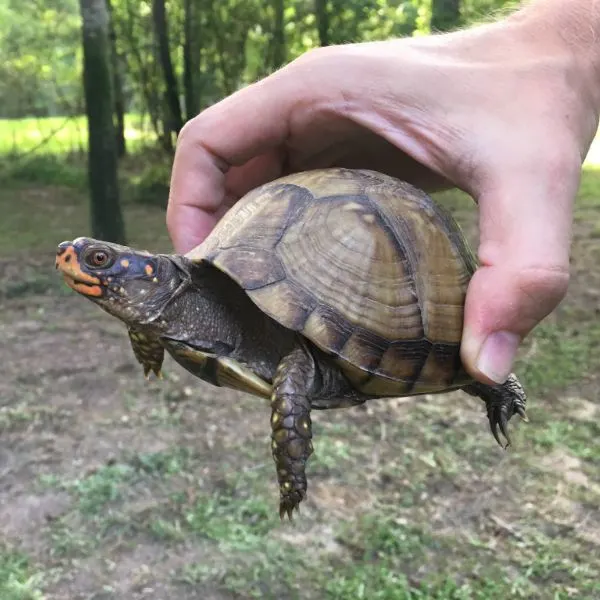
- Experience level: Intermediate
- Family: Emydidae
- Scientific Name: Terrapene carolina triunguis
- Other Names: N/A
- Average Adult Size: 4.5 – 6.5 inches
- Life Span: 70+ years
- Average Price Range: $140 – $430
- Conservation Status: Vulnerable
Three-toed Box turtles are found in small numbers in the far southwestern regions of Tennessee. Though they are a subspecies of the Eastern Box turtle, these turtles live in woodlands, meadows, and other grassland areas.
They don’t swim much either and maintain humidity by burying themselves in soft soil or soaking in small puddles.
These turtles also have high domed shells, but they are light brown to olive and have little to no patterns on them, and they too can enclose themselves in the shell. As their name suggests, they have three toes on their hind legs.
Since these turtles are so terrestrial, they roam the land in search of food. They are omnivores that feed on insects, worms, snails, slugs, mushrooms, and plants. When they find berry bushes or fruits, these turtles will stick around and feed on them until they can no longer reach the berries or finish the fruit.
4) Eastern River Cooter

- Experience Level: Beginner to Intermediate
- Family: Emydidae
- Scientific Name: Pseudemys concinna concinna
- Other Names: River Cooter
- Adult Size: Between 8 and 12 inches
- Life Span: Between 20 and 40 years
- Average Price Range: $20 to $50
- Conservation Status: Special concern
Eastern River Cooters are found in rivers and streams with constant currents across the state. They are often seen basking in large numbers on fallen logs in the water, large rocks, or on the banks of the water.
They can grow rather large and have decorated shells, though they are usually covered in mud. When the shell is clean you will see a slightly raised shell that’s dark green to nearly black with yellow, brown, green, and black markings. The edge and plastron are yellow, and the skin is dark with yellowish stripes.
They tend to be rather shy, so if you get close to them, make sudden movements, or loud noises they will run back to the water and stay there for a long time. Not only can they hold their breath for a long time, but they can also breathe underwater.
There are small sacs in the cloaca that can exchange gasses with the water and allow the turtle to stay submerged for a long time. They can’t stay under indefinitely and will eventually have to return to the surface for a breath, but most predators won’t wait around that long.
River Cooters are mostly herbivorous, so they eat algae, and plants, but will occasionally feed on insects and other invertebrates.
Map Turtles in Tennessee
5) False Map Turtle
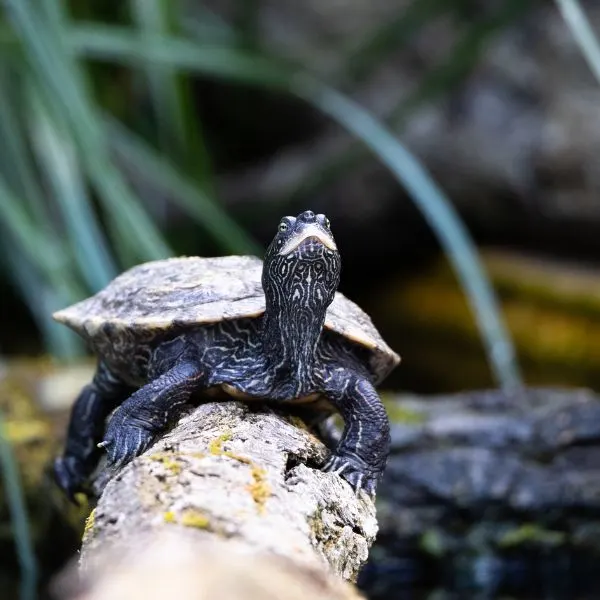
- Experience Level: Beginner
- Family: Emydidae
- Scientific Name: Graptemys pseudogeographica
- Other Names: Sawback turtle
- Adult Size: 3.5 to 10.5 inches (9 to 26.5 cm)
- Life Span: 30 to 50 years
- Average Price Range: $6 to $40
- Conservation Status: Least concern
False Map turtles are aquatic turtles that rarely leave the water. They will come ashore or climb on logs, rocks, or outcroppings to bask, and females will emerge to lay their eggs, but other than that, these turtles stay in the water.
Map turtles have green, olive, or greyish shells with lighter colored swirls and circles that resemble the contours on maps, hence their name. They have dark colored skin and scales with white or yellow stripes. To identify the specific subspecies you’ll have to look closely at the shape of the shell, and the markings on their heads.
On the False Map turtles’ carapace keel, look for darkened bumps that look somewhat serrated. Some map turtles have a solid keel, some have very prominent ridges, and some are lighter colored, but nearly all have a raised ridge. They also have saw-toothed serrations on the back end of the shell.
The markings on a False Map turtle’s head look like an inverted “L” and can be white or yellow.
The False Map turtle is mainly a carnivore, but it will eat some vegetation.
6) Northern Map Turtle
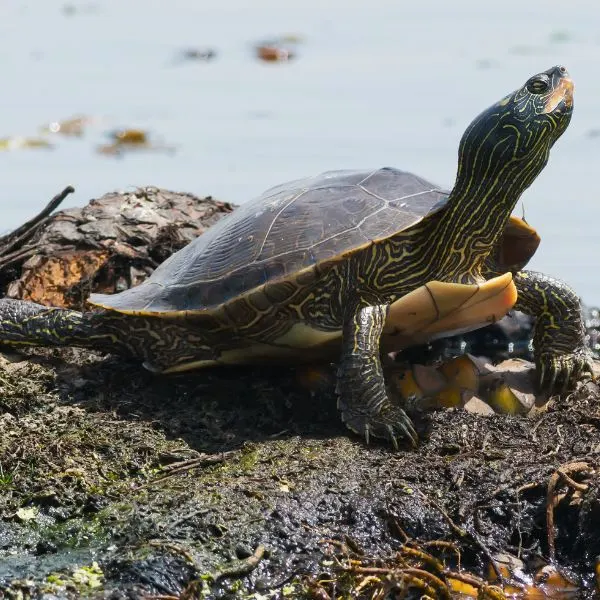
- Experience Level: Beginner
- Family: Emydidae
- Scientific Name: Graptemys geographica
- Other Name: Common map turtle
- Adult Size: Between 4 and 10 ½ inches
- Life Span: 15 to 20 years
- Average price range: Between $20 and $60
- Conservation Status: Least concern
Northern Map Turtles have a less prominent keel that becomes less distinguishable as they age. On their heads, they have circular, or oval spots behind the eyes, and the stripes on the head and neck touch the eyes.
These turtles have a lighter colored plastron with a dark blotch in the middle. Though it will be difficult to get this close to these turtles as they bask in large numbers and always keep an eye out for disturbances.
Like other subspecies of Map turtles, they love waters with currents and are excellent swimmers. Also, females get much bigger than males, nearly twice as large.
The Northern Map turtle is mostly a carnivore. They feed on fish, crayfish, mollusks, and insects, but will sometimes partake of green vegetation.
7) Ouachita Map Turtle

- Experience Level: Beginner
- Family: Emydidae
- Scientific Name: Graptemys ouachitensis
- Other Names: Southern Map turtle
- Adult Size: 3.5 to 10 inches
- Life Span: 15 to 20 years
- Average Price Range: $40 to $100
- Conservation Status: Least concern
Ouachita Map turtles have rectangular or oblong patches of white or yellow behind their eyes. They also have small circles under their eyes and under their chin. They also have a mirrored pattern on the plastron that can reach the outer edges.
One amazing characteristic that has not been noticed in any other North American species of turtle, is the hatchlings will make clicking noises or a kind of “mewing” just before they emerge from the nest.
Ouachita Map turtles can be found in the Cumberland, Mississippi, and Tennessee Rivers.
These Map turtles are more omnivorous than other species. They feed on crustaceans, clams, insects, fish, algae, and other plants such as duckweed.
Mud Turtles in Tennessee
8) Eastern Mud Turtle

- Experience Level: Beginner
- Family: Kinosternidae
- Scientific Name: Kinosternon subrubrum
- Other Names: Common mud turtle
- Adult Size: 3 to 4 inches
- Life Span: 40 to 50 years
- Average Price Range: $20 – $100
- Conservation Status: Least concern
Eastern Mud turtles are small, mostly aquatic turtles with high domed shells. On the edges and back end, the carapace slopes down rather sharply. The carapace is typically brown, olive, or dark brown with no patterns to it.
The plastron is hinged like Box turtles and they can enclose themselves inside. The skin of these turtles is dark grey to black and may have lighter stripes, spots, and blotches.
These turtles are found across most of the state in shallow, slow moving waters. They tend to prefer bogs, swamps, ponds, and drainage ditches with a lot of vegetation.
These small turtles have webbed feet but are not the greatest swimmers. Instead of swimming, most of the time they will crawl along the muddy bottom, or climb up the plants to reach the surface.
In winter they bury themselves in mud to hibernate.
Eastern Mud turtles are omnivores that feed on tadpoles, leeches, worms, insects, fish, crayfish, and plants.
Musk Turtles in Tennessee
9) Eastern Musk Turtle
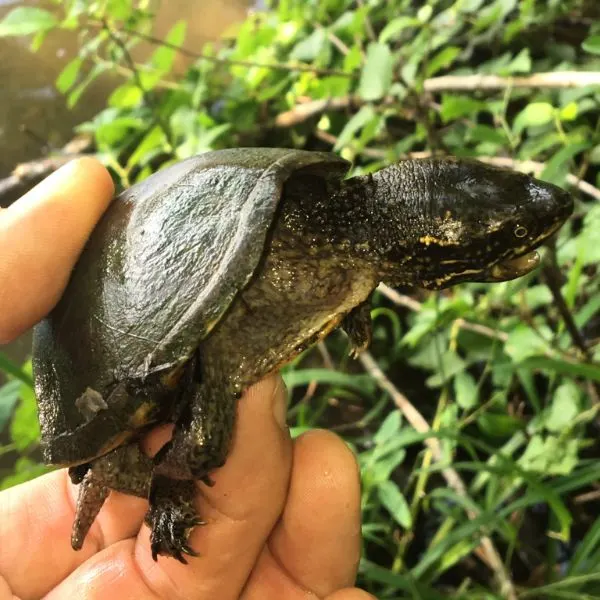
- Experience Level: Intermediate
- Family: Kinosternidae
- Scientific Name: Sternotherus odoratus
- Other Names: Common Musk turtle, Stinkpot
- Adult Size: 4 to 5 inches (10 to 12.5 cm)
- Life Span: 30 to 50 years
- Average Price Range: $30 to $120
- Conservation Status: Least concern
Eastern Musk turtles are called “Stinkpots” by ones in the know. These turtles—and indeed, any species in the Kinosternidae Family—have glands that can secrete a powerful, pungent, stench. If they feel threatened or are harmed, they can mimic the skunk and release a foul smell.
When these turtles aren’t “mucking it up,” they can be found across much of the state, especially central and northeastern areas. Like the Mud turtle above, the Eastern Musk turtle prefers shallow, slow moving waters.
Eastern Musk turtles have similarly shaped shells as the Mud turtle, but this one is usually darker and can have a black starburst type pattern on the scutes. They have wide heads with white or yellow stripes that appear both above and below the eyes.
Be careful handling these little turtles, not only will they use their musk to make you let go, they sometimes have a mean disposition and will try to bite.
These turtles are mostly active at night. While they are moving around in the mud and vegetation they search for aquatic snails, freshwater clams, tadpoles, slow moving fish, crayfish, and insects. They will also feed on the aquatic plants in their habitat.
10) Stripe-necked Musk Turtle

- Experience level: Beginner
- Family: Kinosternidae
- Scientific Name: Sternotherus minor peltifer
- Other Names: Loggerhead Musk turtle, Stinkpot
- Average Adult Size: 3 – 5 inches
- Life Span: 30 to 50 years
- Average Price Range: $400 – $500
- Conservation Status: Threatened
Found mostly along the eastern border in small mountain streams, shallow rivers, and ponds, the Stripe-necked Musk turtle is another mostly aquatic, small turtle. They have an oval shell with a ridge running in the middle of the shell.
As the name suggests they have numerous dark and light stripes running from the head, down the neck. These stripes continue along the limbs, and the carapace may occasionally have a few stripes.
This species is most active during the day and usually feeds in the early morning. They feed mostly on snails, and insects, but will also feed on vegetation in the water.
Painted Turtles in Tennessee
11) Eastern Painted Turtle
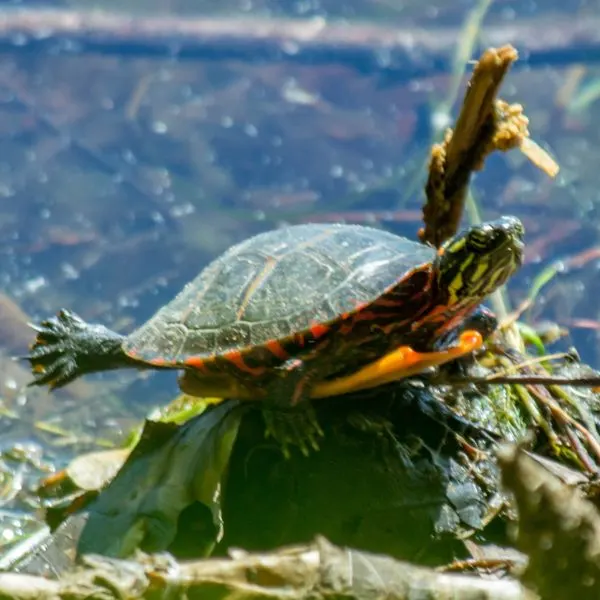
- Experience level: Beginner
- Family: Emydidae
- Scientific Name: Chrysemys picta
- Common Name: Painted Turtle
- Average Adult Size: 4 – 10 inches
- Life Span: 30 – 50 years
- Average Price Range: Between $30 to $150
- Conservation Status: Least Concern
Eastern Painted turtles are mostly found in ponds, small waterways, and slow moving streams along the Blue Ridge Mountains. Look for waters with abundant vegetation such as duckweed and lilypads, as well as logs, brush piles, and rocks for basking.
These turtles have slightly domed shells that are olive, dark brown, or nearly black. The scutes align together to form straight lines on the carapace. The plastron is yellow to tan and has no patterns.
The skin on these turtles is very dark with numerous yellow stripes.
While these turtles are omnivorous, their feeding habits have not been extensively studied. They have been seed eating aquatic plants, tadpoles, insects, and dead or injured fish.
12) Midland Painted Turtle

- Experience Level: Beginner
- Family: Emydidae
- Scientific Name: Chrysemys picta marginata
- Other Names: N/A
- Adult Size: Between 4 and 10 inches
- Life Span: Between 30 and 50 years
- Average price range: Between $30 and $150
- Conservation Status: Special concern
The Midland Painted turtle is mainly found along the Tennessee River drainage. Other than where it is located in the state, this turtle may be difficult to distinguish between the two other Painted turtle subspecies.
They have a similar shell shape, but the scutes are alternating and don’t make any straight lines. From far away, that’s very difficult to see, and these turtles don’t make it easy for you to get in close.
They also have a similar colored plastron to the Eastern Painted turtle, except these have a slightly darker patch in the middle. The exposed skin and scales are also very dark and streaked with yellow stripes.
These turtles too love to bask in the sun and are similarly sized to Eastern Painted turtles.
Midland Painted turtles feed on insects such as caddisflies, and dragonfly larvae, and they will feed on vegetation where they live.
Midland Painted turtles are another species of water turtle in Tennessee and are mainly found in streams that diverge from the Tennessee River.
13) Southern Painted Turtle

- Experience level: Beginner
- Family: Emydidae
- Scientific Name: Chrysemys dorsalis
- Other Names: Painted Turtle
- Average Adult Size: 4 – 6 inches
- Life Span: 20 – 25 years
- Average Price Range: $30 – $150
- Conservation Status: Least Concern
The Southern Painted turtle is the smallest Painted turtle in Tennessee and is found along the western edge of the Volunteer state. You can also easily identify these turtles because they have a reddish stripe running down the middle of the upper shell.
The edge of this turtle’s shell is bright red with darker spots, and the plastron is pale yellow or tan with no patterns. They also have dark brown skin and scales with yellow stripes.
Southern Painted turtles prefer a shallow body of water with a muddy bottom and abundant vegetation. Rivers, ponds, oxbows, and shallow areas in lakes and reservoirs are where you’ll often find these turtles.
The Southern Painted turtle is an omnivore that feeds on tadpoles, crayfish, insects, fish, and vegetation.
Pond Sliders in Tennessee
14) Cumberland Slider

- Experience level: Beginner
- Family: Emydidae
- Scientific Name: Trachemys scripta troostii
- Other Names: Yellow Eared Slider, Troost’s Turtle, Cumberland Turtle
- Average Adult Size: 5 to 11 inches
- Life Span: 40 – 50 years
- Average Price Range: Approximately $40 to $80
- Conservation Status: Least concern
The Cumberland Slider is a medium sized turtle that is found along the Cumberland, Tennessee, and Mississippi Rivers. They were thought to only have been found among these areas, but have recently been seen in Alabama, Georgia, and as far north as Illinois. The pet trade and unauthorized releases are likely the cause of these populations.
Cumberland Sliders have an olive colored shell with yellow, orange, and greenish striping and swirls. The carapace also has a slight keel to it but will smooth out as the turtle ages. Older turtles have rough, wrinkled looking upper shells.
The plastron and bridge are yellow, with black spots on the marginal scutes. On the bottom part of the shell, you can see some dark smudges.
They have dark skin with yellow stripes. Behind the eyes, there are large yellow strips that change color as they get closer to the neck. They can darken to orange or red.
Cumberland Sliders look for quiet waters with a muddy, soft substrate and a profuse amount of plant life. Ponds surrounded by trees, lakes with plenty of undergrowth and aquatic vegetation, and slow streams are where you’ll likely find these turtles.
These turtles are omnivores that feed on plants, algae, seedpods, tadpoles, fish, worms, mollusks, and crustaceans.
15) Red Eared Slider

- Experience level: Beginner
- Family: Emydidae
- Scientific Name: Trachemys scripta elegans
- Common Name: Pond slider, Red-eared terrapin, Water slider
- Average Adult Size: 6 – 8 inches
- Life Span: 20 to 40 years
- Average Price Range: approximately $30 to $100
- Conservation Status: Least concern
Red Eared Sliders look very similar to Cumberland sliders. They have a very similar looking carapace, complete with bright colorations, and a slight ridge along the middle. They even have a plastron that is similarly colored.
Red Eared Sliders have dark smudges on the bottom part of the shell, but individual turtles can have several or only one or two. The best way to determine the difference between these two turtles is to look closely at the patches behind the eyes. Red Eared Sliders have a solid red colored patch.
Though they are great swimmers, Red Eared Sliders prefer lazy waters with very little current. Lakes, reservoirs, oxbows, and slow rivers are where you’ll find these turtles.
They also need a profusion of basking sites. When basking real estate is rare, these turtles will bully off other species, and sometimes climb on top of each other.
Red Eared Sliders eat nearly anything. They can feed on fish, carrion, insects, crayfish and other crustaceans, mollusks, insects, and all types of vegetation.
16) Yellow Belly Slider

- Experience level: Beginner
- Family: Emydidae
- Scientific Name: Trachemys scripta scripta
- Other Names: Pond slider, Yellow slider
- Average Adult Size: 5 – 13 inches
- Life Span: 50 to 100 years
- Average Price Range: approximately $30 to $130
- Conservation Status: Least concern
Yellow Belly Sliders are semi-aquatic turtles similar to Red Eared Sliders. They spend more time on land though. Yellow Belly Sliders will traverse dry land in search of mates, and better suited waters.
They often inhabit wetlands, ponds, floodplains, and other seasonal waters. When these areas dry up, the turtles will wander long distances searching for more water. They will also inhabit permanent waters such as lakes and rivers as well.
These turtles have darker shells, with less patterning compared to our previous two entrants. The carapace is brown to black with some yellow striping. This yellow fades and darkens as the turtle ages.
They also have dark skin with yellow stripes, but their stripes are thicker, and there is no red or orange. The plastron is yellow with dark spots on the outer edge.
In Tennessee, these turtles live in the western half of the state.
Yellow Belly Sliders are omnivores. They feed on all types of vegetation as well as fish, insects, worms, and other invertebrates.
Snapping Turtles in Tennessee
17) Alligator Snapping Turtle

- Experience level: Expert
- Family: Chelydrida
- Scientific Name: Macrochelys temminckii
- Common Name: Loggerhead Snapper
- Average Adult Size: 13-30 inches
- Life Span: 30 – 50 years
- Average Price Range: Approximately $50 to $300
- Conservation Status: Threatened
Alligator Snapping turtles are the biggest freshwater turtles in North America. They have ridged, spiked upper shells, very long tails, and extremely wide heads. Their skin is covered in fleshy warts and bumps and they have strong, muscular limbs.
In the water, these turtles are very docile, but if they get pulled out of the water, they can have a negative disposition. Much like me, when I get forcibly yanked outdoors I can become cranky too, only I don’t have a 1,000-pound bite force!
These giants don’t like to leave the water and will stay at the bottom of lakes, rivers, swamps, and reservoirs. Here they wait for food to come near so they can strike out and gobble them up. On their tongues, Alligator Snapping turtles have a worm-like projection they can wiggle to attract prey.
They are very rare in Tennessee and listed as “in need of management” by the state. Hunting, harvesting, and habitat loss are the main threats to this turtle’s population.
The shell and skin of these turtles range from green to dark brown. The plastron is very small and white or cream colored.
Alligator Snapping turtles are carnivores. They feed on fish, snakes, amphibians, smaller turtles, and anything else that fits in their mouths.
18) Common Snapping Turtle

- Experience level: Intermediate to Expert
- Family: Chelydrida
- Scientific Name: Chelydra Serpentina
- Other Names: Snapping Turtle, Snapper, Eastern Snapping Turtle
- Average Adult Size: 8 to 20 inches
- Life Span: 30 – 50 years
- Average Price Range: Approximately $40 to $120
- Conservation Status: Least concern
Common Snapping turtles are similar to the Alligator Snapping turtle, but they are smaller and a little less intimidating looking. That doesn’t mean they are any nicer though. The Common Snapping turtle may actually be more aggressive, at least on land.
When these turtles come onto dry land, it’s best to give them plenty of space. If you get too close they will hiss loudly as a warning, if that doesn’t do the trick, they can strike out with a very long neck and deliver a nasty bite.
Common Snappers have a smoother shell with three less prominent ridges. They have hook shaped heads, big legs, and a long tails too.
Their skin can range from dirty yellow to dark brown. Their carapace is solid olive or dark brown. It can often appear greenish, but that’s from the algae that often grow on their shells.
These turtles don’t often bask, and when they do, they often just swim to the surface for a while before returning to the bottom. They inhabit ponds, lakes, and slow moving rivers with muddy waters and vegetation, and can be found all across the state.
Common Snapping turtles hide at the bottom of the water in the mud and vegetation waiting for prey to come close. They feed mostly on protein sources such as fish, frogs, tadpoles, crayfish, and more, but they will also consume plant matter.
Softshell Turtles in Tennessee
19) Midland Smooth Softshell Turtle

- Experience level: Intermediate
- Family: Trionychidae
- Scientific Name: Apalone Mutica
- Other Names: N/A
- Average Adult Size: 5 – 14 inches
- Life Span: 10 – 20 years
- Average Price Range: $50 – $150
- Conservation Status: Least Concern
The Midland Smooth Softshell is a unique looking turtle. All Softshell turtles look similar as they don’t have hard shells like most turtles. Instead, they are wide, flattened turtles with soft, leathery, or rubbery carapaces.
You can often see outlines of vertebrae and ribs on the upper sides of these turtles. They also have pointed, pig-like snouts that help them reach the surface easier when they are at the bottom of the water.
The Midland Smooth Softshell turtle can be seen along the northern rivers. They prefer clean waters with sandy bottoms so they can easily camouflage themselves and snap up aquatic creatures.
These turtles are sandy colored or dark brown with some darker colored circles or spots on the carapace. They have very long necks, and stripes running from the snout to behind the head.
Female Softshell turtles are usually 2 times as big as males. They are also more oblong shaped, while males tend to stay more circular.
Softshell turtles are mostly carnivorous. They will feed on fish, insects, tadpoles, carrion, crayfish, and mollusks.
20) Spiny Softshell Turtle
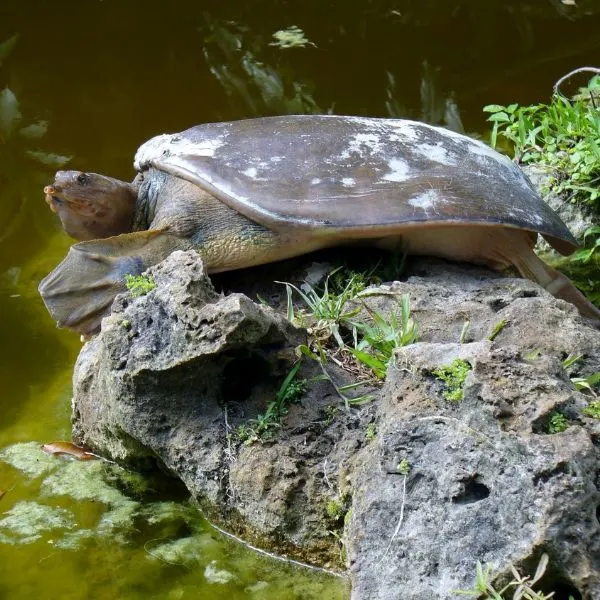
- Experience Level: Intermediate to Expert
- Family: Trionychidae
- Scientific Name: Apalone spinifera
- Other Names: N/A
- Adult Size: 5 to 9 ½ inches for males, 10 to 17 inches for females
- Life Span: Between 20 and 50 years
- Average Price Range: Between $20 and $120
- Conservation Status: Threatened in some areas
The big difference between Smooth Softshell turtles and Spiny Softshells is the bumpy, “spiny” projections along the frontal ridge and along the rest of the carapace.
They have the same type of coloration and similar habits. They also like to bury themselves in sandy substrate and strike out at prey. They are great swimmers and don’t have trouble actively hunting prey.
Softshell turtles are not only expert swimmers, but they are very fast on land. Aside from being fleet-footed, they can be aggressive out of the water as well. They know they don’t have much protection on land so they make up for it by being downright mean.
These turtles are carnivorous and feed mostly on fish, crayfish, mollusks, amphibians, and other protein sources.
FAQs
Are turtles illegal in Tennessee?
The laws surrounding pet turtles in Tennessee have had a complicated history. Turtles were banned as pets in 2012, but that has since been repealed.
You can now legally own a pet turtle in Tennessee, but you need a permit, and the turtle can be taken from the wild. There are also certain species of turtles you can’t own at all such as the Bog turtle.
Be sure to do your own research before purchasing a turtle in Tennessee to make sure you aren’t accidentally breaking the law.
Can you have a pet tortoise in Tennessee?
Yes, you can have a pet tortoise in Tennessee as long as you follow the correct laws of ownership.
Owning a tortoise isn’t the same as caring for a turtle. Tortoises don’t swim and need drier habitats, and often get large, so you may need to keep them outside. Cold temperatures can be an obstacle to keeping a tortoise as it will probably brumate during winter and will require certain equipment and housing.
Are turtles common in Tennessee
There are several species of turtles in Tennessee, but some are more common than others. Species such as Spiny Softshell, Common Snapping, Painted, Red Eared Sliders, and Mud turtles are fairly common in the state. Nearly all turtle species are in decline because of habitat destruction and road mortalities.
Wrapping up
And that friends, was a list of 20 turtles found in Tennessee. As you can see, there is plenty of variety amongst these unique reptiles, and if you’re very observant you may see a lot of them while you are out and about in the Volunteer State.
We hope you have enjoyed this list. If you did, please leave a comment below. We love to hear from our readers, and who knows, maybe you can connect with fellow herp enthusiasts as well.
Other nearby states
- Turtles in Alabama
- Turtles in Arkansas
- Turtles in Georgia
- Turtles in Kentucky
- Turtles in Mississippi
- Turtles in Missouri
- Turtles in North Carolina
- Turtles in Virginia
